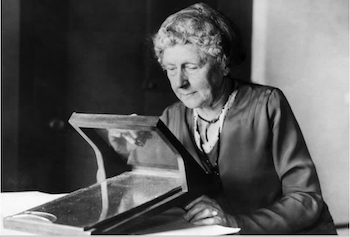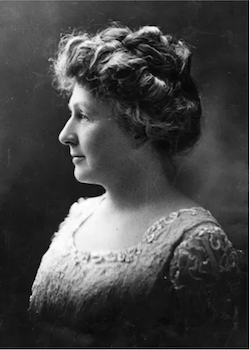Annie Jump Cannon was born to Mary and Wilson Cannon, a shipbuilder and state senator, on December 11th, 1863, in Dover, Delaware. Cannon was the youngest of three daughters and had a close relationship with her mother. Cannon inherited an interest in astronomy from her, and the two would spend their nights gazing at and observing constellations in the night sky from a homemade observatory in their attic. Despite the stigma around women’s education and widespread sexism of the late 19th century, Cannon’s parents encouraged and supported her pursuit of higher education. Thus, Cannon graduated as valedictorian from Wellesley College in 1884 with a degree in physics and astronomy.
In the years following her graduation, her career and education in astronomy were put on hiatus as Cannon decided to pursue traveling and photography instead. During this period, she contracted scarlet fever, resulting in hearing loss that eventually developed into complete deafness. Mary Jump also passed away in 1894, leaving Cannon grieving and heartbroken over the loss of her mother, supporter, and inspiration. The loss of the woman who first sparked her passion for the stars likely influenced Cannon’s decision to return to her career in astronomy that very year.
She resumed her study of astrophysics at Wellesley under Professor Sarah F. Whiting. A year later, in 1895, she enrolled in Radcliffe College, the female counterpart of the all-male Harvard College. She started her position as an assistant at Harvard’s observatory in 1896 under Director Edward C. Pickering. Cannon was one of the many female employees of the observatory and collaborated with many during her work on Pickering’s long-term project of classifying stars through their spectra, a translation of a star’s light into a spectrum taken through a spectroscope. Information, including a star’s size and temperature, could be gleaned from stellar spectra, which efficiently enables the grouping of stars of similar characteristics; a system of classification based on stellar spectra would be a consistent, accurate way to group stars of similar characteristics together. Williamina P. S. Fleming, one of Cannon’s colleagues, categorized stars and their spectra into seventeen categories, named A to Q. Cannon built upon Fleming’s work and simplified the seventeen categories into seven main ones, O, B, A, F, G, K, and M, and two additional ones, P and Q, for planetary nebulae and miscellaneous stars, respectively. She further added numerical subdivisions, 0 to 9. This system of classification of stars was soon accepted by astronomers worldwide and officially adopted by the International Astronomical Union in 1922. Today, Cannon’s classification system is more commonly known as the Harvard Spectral Classification System and has widespread use and relevance in the scientific community.
In addition to creating an effective and accurate classification system, Cannon captured, recorded, and classified the spectra of more than 225,000 stars. In addition, she discovered 300 variable stars, or stars whose characteristics observably change, five novae, and a binary star. Her work was published in the Henry Draper Catalogue, a project funded and supported by Draper’s widow, Mary Anna, in nine volumes published throughout 1918 to 1949.
Cannon’s career was not free of struggles from sexism and ableist discrimination. When Cannon was promoted to the position of Curator of Astronomical Photographs at Harvard College’s Observatory, Harvard refused to officially recognize her position and excluded her name from the university’s catalog. It was not until mere years before her retirement that she was recognized officially as a member of Harvard when she was given due credit and named Harvard’s William C. Bond Astronomer.
Annie Jump Cannon officially retired in 1940. In her lifetime, she did not marry nor have any children. She continued her work even after retirement, up until her death on April 13, 1941, in Cambridge due to heart disease. Throughout her life, she followed her passion for astronomy, coupled it with her love of photography, and created a vital stellar classification system still used today. Despite her gender and disability in a period of widespread sexism and ableism, she proved her intellect and competence. Her accomplishments are not only a testament to her own work and talent but also to that of the numerous underrecognized female assistants and computers that progressed the field of astronomy. She was honored with numerous honorary degrees from accredited academic institutions, including the University of Groningen, Wellesley College, Oglethorpe University, Mount Holyoke College, and from her own state, the University of Delaware. Cannon also became the first woman to receive an honorary doctorate from Oxford in 1925. She received numerous accolades, including the Henry Draper Medal from the National Academy of Science and the Ellen Richards Prize. The first woman to become a female officer of the American Astronomical Society, Cannon worked to pave the way for future female astronomers and established an award in her name to honor promising young postdoctoral astronomers. A suffragette, Cannon was also a member of the National Women’s Party of the United States. Today, Cannon is credited as a pioneer astronomer and with the creation of the Harvard Spectral Classification System. The lunar crater Cannon is named after the astronomer, and her face silhouette appears on Delaware's one-dollar coin.
Why Did I Choose to Research Annie Jump Cannon?
While working on project PHaEDRA (Preserving Harvard’s Early Data and Research in Astronomy) to transcribe data recorded by women computers and astronomers at the Harvard College Observatory, I came across many names, including Annie Jump Cannon’s. Upon further research, I was fascinated by her dedication to her passion and how she overcame the sexism and ableism she likely faced during her time. My own childhood love for astronomy has recently been rekindled because of my AP Physics class. As I explore my own future in astronomy and physics, I look back to appreciate and admire the work done by amazing women like Annie Jump Cannon.
Works Cited
30 Best Annie Jump Cannon Quotes With Image. Bookey. (2023, September 19). https://www.bookey.app/quote-author/annie-jump-cannon#:~:text=Annie%20Jump%20Cannon%2C%20a%20renowned,and%20the%20wonders%20it%20unravels
Annie Jump Cannon. (n.d.). Brooklyn Museum. Retrieved April 4, 2024, from https://www.brooklynmuseum.org/eascfa/dinner_party/heritage_floor/annie_jump_cannon
Annie Jump Cannon Award in Astronomy. (n.d.). American Astronomical Society. Retrieved April 4, 2024, from https://aas.org/grants-and-prizes/annie-jump-cannon-award-astronomy
Cannon. (n.d.). We Name The Stars. Retrieved April 4, 2024, from https://wenamethestars.inkleby.com/feature/1005
Christ, M. (2022, January 16). Annie Jump Cannon. American Philosophical Society. Retrieved April 4, 2024, from https://www.amphilsoc.org/blog/annie-jump-cannon
The Editors of Encyclopaedia Britannica. (2024, February 20). Annie Jump Cannon | American Astronomer & Women's Rights Activist. Britannica. Retrieved April 4, 2024, from https://www.britannica.com/biography/Annie-Jump-Cannon
Harvard Spectral Classification | COSMOS. (n.d.). COSMOS - The SAO Encyclopedia of Astronomy. Retrieved April 4, 2024, from https://astronomy.swin.edu.au/cosmos/h/harvard+spectral+classification
Palma, C. (n.d.). Variable stars | Astronomy 801: Planets, Stars, Galaxies, and the Universe. PennState College of Earth and Mineral Sciences. Retrieved April 4, 2024, from https://www.e-education.psu.edu/astro801/content/l7_p8.html
Smith, K. N. (2018, December 11). Tragedy And Illness Brought Astronomer Annie Jump Cannon Back To The Stars. Forbes. Retrieved April 4, 2024, from https://www.forbes.com/sites/kionasmith/2018/12/11/tragedy-and-illness-brought-astronomer-annie-jump-cannon-back-to-the-stars/?sh=3ab36c347745#5ff1055b7745
Smith, L. (2015, March 15). Annie Jump Cannon -. Project Continua. Retrieved April 4, 2024, from https://www.projectcontinua.org/annie-jump-cannon/
United States Mint. (2019, October 31). Delaware American Innovation™ $1 Reverse Proof Coin on Sale Nov. 7. United States Mint. Retrieved April 4, 2024, from https://www.usmint.gov/news/press-releases/delaware-american-innovation-1-reverse-proof-coin-on-sale-nov-7
Waterfield, R. L. (1941, June 14). Dr. Annie J. Cannon. Nature, 147, 738. https://doi.org/10.1038/147738a0
This article was published on 6/14/24


